Today I want to talk about chord inversions and how they can be used to make your compositions sound more elegant and colourful.
All examples in this post will be using simple major and minor chords, but the theory presented here applies to all types of chords.
Chords consist of a number of notes that are played either simultaneously or sequentially (arpeggio).
Major and minor chords are triads of notes. These triads consist of a root note, a third and a fifth. The fifth is a perfect fifth, being exactly 7 semitones higher than the root note and the third can either be 3 (minor third) or 4 (major third) semitones above the root.
E minor consists of E (root), G (minor third) and B (fifth). When you create a chord progression, let’s say Em – Am – F – G, you might be inclined to just shift your fingers to the new chord, so you would play: E,G,B – A,C,E – F,A,C – G,B,D. However, this chord progression would sound rather clumsy, because the cords do neither flow naturally into each other nor are there any variations in the feel of the chords – except the change from major to minor of course.
How can you add more colour to your chord progressions? With chord inversions :)
E minor consists of the 3 notes E, G and B. Now if we took the E from the bottom and placed it at the top of the chord, above the B, we would still be playing an E minor chord, but with a G in the bass. This chord is usually written as Em/G (“E minor with G in the bass”) and is the first inversion of E minor.
The second inversion is Em/B, consisting of the notes B, E and G. The following picture shows the root position, first and second inversions for the E minor and major chords:

Have a listen to both the E minor and major chords and their inversions:
It might be hard to tell the feel of the chords apart simply because the notes are so obviously being shifted up and each one chord sounds higher than the previous one.
I have created another example, using the exact same chord inversions, but rather than playing just the triad, I am playing the chord in the root position with the right hand and am playing a bass note with the left. For each inversion, I am only changing the bass note. This might make it easier to discern the feel the chords create:
Now while the chords consist of the same notes independent of the inversion, they feel very different. They are all conchords (rather than dischords) so they will sound harmonious, however you will notice that
- The chord in the root position sounds very solid, grounded and stable
- The first inversion adds slight tension and feels less stable
- The second inversion creates alot of tension and wants to resolve to another chord – preferrably a chord in root position.
The second inversion can work well at the end of a verse or bridge for that very reason.
Coming back to our initial chord progression Em – Am – F – G, we can make this progression sound alot more interesting by using chord inversions :)
By applying clever chord inversions we can
a) make the transitions less clunky by minimising the changes in notes required for each chord change and
b) add colour to the sequence by introducing some tension
One possibly way to play the chord progression would be E,G,B – E,A,C – F,A,C – G,B,D. If you play this sequence, it will sound alot more fluent than the initial, clunky version. Note that the transition from F to G is still a parallel shift of notes, which may or may not be desired.
Again, this is just one possibility. Experiment with how many variations you could come up with for this simple chord sequence and decide for yourself which one you like best!
Finally, I have created two little song fragments to demonstrate the theory of this post in the context of a composition :)
Both fragments make use of exactly the same chord progression: F – A – C – G – F – A – G – G (repeated). However, one of them does not make use of chord inversions, whereas the other one does.
First off, here is the composition for the version that does not employ chord inversions:
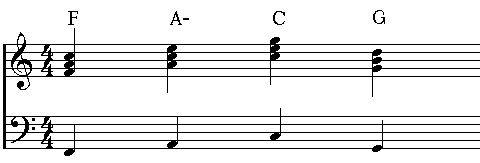
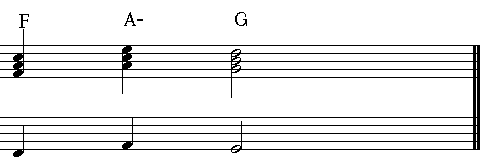
I have a bass guitar in the arrangement, but it only plays the root notes of the chords. Have a listen and you will hear the obvious shifts during the chord transitions. While not horrible, there is something unnatural and disconnected about this sequence.
The second version of the song fragment uses chord inversions for both minimising note changes for the piano as well as introducing colour and tension where appropriate. Here is the composition for this improved version of the song:
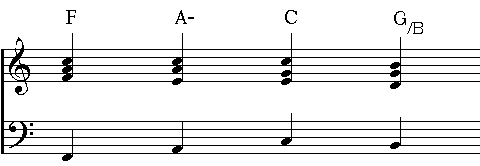
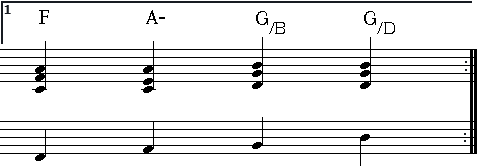
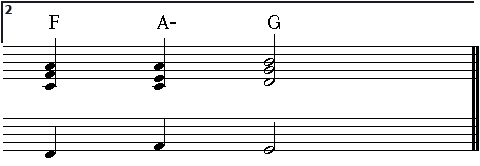
Now have a listen to this version of the song. The bass guitar plays the bass note as depicted in the score above, e.g. during G/B, the bass will play the B. I especially like G/B, G/d inversions at the end of the second bar and the transition back to the F.
Chord inversions are very simple to employ, yet they can add alot of elegance, colour and variations to your songs. Next time you create a chord sequence, experiment a little with the inversions – you will be surprised how much most progressions can still be improved :)



